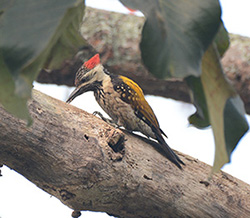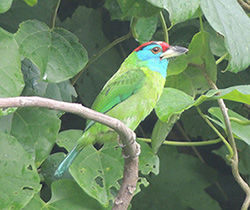



The University campus has been the suitable habitat for woody flora as well as dense patches of herbaceous plants including climber and grasses that provides natural habitats for birds, butterflies, insects and snakes. There were transformation and redeemed of certain natural vegetation patches for requisite infrastructure development to facilitate the emerging needs for the growth of the university. However, spaces for academic, administrative and recreational areas are delineated in harmony with the landscape to ensure an eco-friendly campus. The greenery of the large area in the campus is well maintained besides keeping remnants of the natural vegetation patches undisturbed. There are block plantation, plantations along roads side, garden space of departmental building premises, and along the residential compounds, while several tree species regenerated naturally and there are seasonal herbaceous plants that cover the whole natural landscapes. Several indigenous trees, shrubs and ornamental plants are carefully selected for the plantation to provide shelter for birds and to deliver a shaded walkway.
Towards the sustainable land use practice, a total of 24,978 numbers of different plants have been planted in various sites within the campus in the last 2 decades. There are around 100 different tree species consisting of evergreen, semi-evergreen and deciduous trees. The University has also maintained two ‘Citrus gardens’ and a botanical garden. The botanical garden has an orchid house and a fern house beside having number of trees, shrubs, climbers, herbs and bamboos. There are medicinal plants, timber plants, fruit bearing plants, sacred plants and RET (Rare, Endangered and Threatened) plants species.
More than 55 varieties of birds and 72 varieties of butterflies are recorded from different habitats within the campus. Presence of large number of butterflies and birds indicates healthy ecological system and sheltered areas for their orientation or basking. This vast natural setting of green campus indeed bestows a visual treat and gesture of eco-friendly culture unique to Tezpur University. There are water bodies fed by rainfall and artificial recharging which also serve as habitat for number of wild and semi-wild water birds such as egrets, whistling ducks or tree ducks, white- breasted waterhen, snake neck water birds and others. These water bodies along with the associated plants in the surrounding areas are also home to dragonflies, butterflies and semi-aquatic rodent.
Appropriate efforts are in place to make the campus a “green and eco-friendly” space to highlight the ecological significance of green coverage and to ensure quality of life for the campus dwellers and safeguarding the biodiversity. The overall elements of the campus speak about the morale of the University campus aiming at maintaining and protecting natural resources and increasing their resources through greening the various sites with trees.


.jpg)
